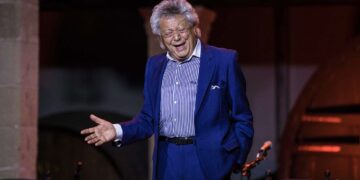|
|
|
SPECIAL COVERAGE: BIENAL DE FLAMENCO DE SEVILLA 2010 «UN CANTO A LA LIBERTAD» Pansequito Cante: Pansequito; Guitar: Diego del Morao , Manuel Parrilla; Piano: Diego Magallanes; Violin: David Moreira; Palmas: Rafa Junquera, Eléctrico, Luis Peña, Javielito Heredia. Text: Gonzalo Montaño Peña. There’s a saying in Spanish: “if it’s good and it’s short, that’s twice as good”. And that’s what came to mind last night with singer José Cortés “Pansequito”. A recital of just barely an hour, but of a very high level. It was one of the most anticipated shows of the Bienal, and it didn’t disappoint anyone. From the first moment you could tell he was going all the way, opening with soleá por bulería accompanied on the guitar by Diego del Morao. His voice is perfect, in tune and on top of the compás. The lines are lengthened, stretched out like a flamenco yo-yo. His experience and taste allowed him to fit a cabales ending into soleá. “An old devil is wise for being old, not for being a devil”, and the young virtuoso guitarist didn’t catch the moment; this singer suprises everyone with his knowledge. The siguiriya is the clincher: we are witnessing something big. Paco la Luz and Cagancho in the voice of Panseco sounded like pure gold. Pity that Bono (U2 was performing just a few meters from the Teatro Central) didn’t attend this recital, his concert would surely have gone even better. In alegrías, this singer’s rhythmic command allowed him to play with time as if he were Chronos. The cante goes round and round and back and forth and comes out just right. The guitar of Manuel Parrilla coddles and encourages the whole process. “No one is more important than anyone else” sings Panseco, but it’s clear we are hearing one of the greats, the kind of singer who knows how to stir passions. The taranto of Manuel Torre was sheer intensity, a fight with the music that José Cortés of course won. His sidekick in the battle, Manuel Parrilla, provided the necessary arms with plenty of flamenco substance and rich melodic and harmonic details. The singer had a good time in the bulerías ending with “A quién le dejo mi cante”, laidback compás with a feeling of earth and sea united. Then, “No me importan lo que digan” from the late singer Jero, and some short styles to close leaving the compás of Pansequito still hanging in the air and reverberating in my head the rest of the night…or maybe the rest of the week, too soon to tell….. ”Hibiki (este-oeste)” Cía. Yoko Komatsubara Dance: Yoko Komatsubara. Piano: David Peña “Dorantes”. Taiko (drum): Eitetus Hayashi. Eitetus fuun no kai: Shuichiro Ueda, Mikita Hase, Makoto Tashiro, Takuya Taniguchi. Dance: Currillo de Bormujos, El Junco, David Sánchez, Javier Sánchez, Andoitz Ruibal, Ryota Takagi. Cante: Juan José Amador, Natalia Marín. Guitar: Juan Carlos Berlanga, José Manuel Tudela. Percussion: Tete Peña. Cello: Gretchen Talbot. Sax: Nacho Gil. Double bass: Manolo Nieto. Corps de ballet: Tomoko Ishii, Kaori Haeno, Yoshie Taira, Keiko Inoue, Yoshie Tani, Akiko Niva, Kie Tajiri, Yoko Tamura, Yuka Kitayama, Miho Watanabe, Tomoko Tamaoki, Mika Danno. Director: Yoko Komatsubara. Choreography: Yoko Komatsubara, Maribel Gallardo, Currillo de Bormujos, Cristian Pérez, David Sánchez. Music: Eitetsu Hayashi, David Peña “Dorantes”, Juan Carlos Berlanga. I’ve never seen the Teatro de la Maestranza so empty; offhand I’d say no more than 30% of the seats were occupied. Pansequito’s recital at the Teatro Central at the same hour, and which my colleague reports on above or below, depending on the webmaster’s whim, had something to do with it, but still… In the first place, and believe me, I regret having to be the bearer of bad news, it’s not possible to judge a flamenco show done by Japanese artists without always coming back to the same thing. I wouldn’t have thought so, but last night I observed this, and make no mistake, this is how it is. I especially noted it in the audience reaction and the comments afterwards. “They’re so precious”…(not pretty, but precious)…”like little porcelain dolls”…(of course, those precious little faces…gimme a break!)…”it’s admirable!”…(yes, and some of my best friends are Japanese…I’ve heard that line somewhere before)…”and so perfect!”. That no, because surprisingly there were unforgivable moments of little discipline in the corps de ballet. So, I can only conclude that saying “perfect” either reflects a preconceived stereotype about the oriental mentality (millimetric precision and all that), or reflects the extreme indulgence of an audience predisposed to sample something “exotic” and overlook all flaws. I don’t know whether Yoko Komatubara, the grande dame of Japanese flamenco, is happy with that sort of backhanded praise to celebrate the fortieth anniversary of her company, and for which we send our most sincere congratulations. But she failed to take advantage of the opportunity of a lifetime to bring a numerous company with a big budget to the most prestigious theater of the most important flamenco festival in the world. Yes, she brought the company, but the result, in my opinion, did no favor to all the foreigners devoted to flamenco and who expect to be judged on equal terms with Spaniards. This is a program of independent dances with no story line beyond seeking out the common elements of east and west, and which is largely based on dance-school type choreographies: a large group of people facing the audience and doing the same steps. And it was way too long. Reminds me of a line from Woody Allen in reference to a certain restaurant: “the food is terrible….and the portions are so small”. In this case, it was a mediocre buffet served in large portions, an unfortunate inversion of the Spanish saying “if it’s good and it’s short, that’s twice as good”. I had attended this show with the firm desire to be able to report back that flamenco is truly universal, that anyone who grabs hold of it strongly enough, with dedication and love, can end up interpreting it in as dignified a way as any individual born into the most flamenco family of Andalusia. And maybe it’s true, but this company demonstrated exactly the opposite with outdated choreographies and poor taste. It’s possible that with expert advice (Komatsubara takes credit as director and choreographer), the beautiful designer wardrobe and excellent lighting would have contributed to a more worthy result, but not even the admirable dancing of Junco or the lovely music of Dorantes were able to save “Hibiki”. ”PASEO POR EL AMOR Y LA MUERTE” Fernando Romero Text: Estela Zatania Dance: Fernando Romero. Guest dancer: José Antonio. Cante: Miguel Ortega. Guest singer: Arcángel. Original idea and choreography: Fernando Romero. Artistic director: Pepa Gamboa. Music: John Cage, Toru Makemitus, Yoritsune Matsudaira, Collage of classic singers. For some years now, the word “daring” applied to a flamenco work has been enough to inspire fear in the hearts of flamenco fans the world over. This word has now been displaced by “conceptual”…just writing it makes me tremble. And I was trembling for the hour and a half of “Paseo por el Amor y la Muerte”, a conceptual work based (believe it or not) on Dante’s Divine Comedy according to the program notes. Right off the bat I want to emphasize that above all else, in my opinion the single most surprisingly flamenco element in this endeavor, the person who exhibited the highest quality and artistic truth, was singer Arcángel. But let’s begin at the beginning… It was a brilliant minimalist distribution of power as described in the program: “Dante – Fernando Romero/Arcángel, Virgil – José Antonio/Miguel Ortega”. Two characters interpreted by four artists, and no one else live on stage, not even a guitarist. The grey abstract stage-set was a series of doors through which the artists went in and out…mysterious techno music, an off-stage voice that speaks in Italian, and another that briefly alluded to gypsy versus Andalusian cante, a red light that bathed everything to suggest “hell”… There are numerous tricks such as not dimming the house lights until the work is well underway, allowing the musical background normally used during the seating period to sound faintly through the beginning of the show, or using the central aisle through the audience for entrances and exits that reveal an excessive desire to be hip at all costs. But art triumphs over all the obstacles. José Antonio, who announced his retirement just one month ago at the La Unión Festival, retakes the stage with his intense presence. Fernando Romero, maestro of modern dance tinged with flamenco is fascinatingly creative. Miguel Ortega, recent winner of the Lámpara Minera exhibited his knowledge and power. However, the most surprising thing was the transformation of Arcángel, deprived of theatrical niceties, synthesizers, fancy suit and designer coiffure, looking like an average guy, vulnerable, face-to-face with cante as most flamenco fans know it. When the show begins, he nonchalantly gets up from the seat he’s occupying in the front row, sits on the edge of the stairs that lead to the stage and sings soleá without accompaniment. Between fragments of dance, various comings and goings, there is caña, peteneras, toná liviana, bambas and marianas (the latter two by Ortega), sevillanas in which Ortega plays for Arcángel and then for himself, an old-style rumba… And all this is going on in hell mind you. There is a great deal of recorded cante that is not attributed. For God’s sake, how difficult can it be to credit people like Perrate, Bernarda de Utrera, Diego del Gastor, Pepe Pinto, Pastora Pavón, Carmen Amaya or Sabicas among others? Just four decades after these people are gone, how can they be so unworthy of admiration that we permit their art to be lumped under the heading of “classic oldtimers”? Where is the Spanish Society of Authors when we need them most. The bottom line is, some interesting ideas which lack coherence were perhaps the reason for the chilly applause at the end, but I’m happy to have discovered what Arcángel is capable of. Let’s hope the experience of singing without all the paraphernalia he’s accustomed to was rewarding enough to make him want to repeat the experience. |
Descubre más desde Revista DeFlamenco.com
Suscríbete y recibe las últimas entradas en tu correo electrónico.


























